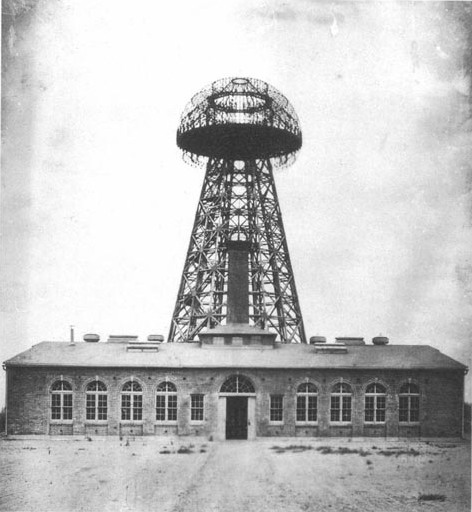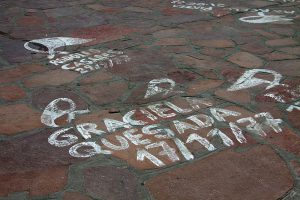Massive streaks of lightning flashed hundreds of feet into the air to touch the night sky, all stemming from the mysterious machine. For a brief moment, the entire atmosphere was filled with bright shafts of electricity. Succeeding arcs, longer and more intense, appeared to disappear into the darkness on some mysterious errand. This was the culmination of Nikola Tesla’s most audacious project yet, Wardenclyffe Tower, a 187-foot-tall tower with a 55-ton metal dome resting atop it, and beneath this enigmatic structure lay an iron root system that delved 300 feet into the Earth’s crust. The sole purpose of this building—to change the world forever.1
This would not be the first time that one of Tesla’s inventions would affect humanity; his technology was prevalent in the world’s evolving electrical appliances, some of which included the radio transmitter, fluorescent lamps, the Tesla coil, and his most famous innovation being the modern design of alternating current technology. It was this triumph over Thomas Edison in the well-publicized Battle of the Currents that contributed to his reputation as one of the world’s greatest electrical engineers. It was an episode in which Edison’s direct current was proved to be far more inferior to Tesla’s alternating current. But his most bold and innovative project was yet to be produced.2

Tesla’s idea of wireless transmission of power can be traced to an 1891 lecture in New York City given by Tesla for the American Institute of Electrical Engineers. During the demonstration, he showed a remarkable display of electricity traveling through the air, facilitated by a pair of metal sheets that hugged the stage. The self-assured Tesla stood between the large zinc sheets, holding in each hand a gas discharge tube, unaccompanied by wire, that emitted a radiant light luminous enough to light up an entire room. The audience was mesmerized by this display, but Tesla continued to ponder how this phenomenon could be applied on an even larger scale—even possibly to the entire globe, and he was not a man to be underestimated.3
By the end of the 1890s, Tesla’s New York laboratory was not suitable or large enough to test his theories regarding the earth’s electrical properties. In May of 1899, the curious inventor traveled to Colorado Springs with the intent to unravel the mysteries of electromagnetism, but more importantly, to pursue the concept of a world wireless system, a system that would provide the world with raw energy and power without the utilization of wires.4 Thus, after obtaining sizable donations from his wealthy friends and the guarantee of free electricity from the El Paso Power Company, the ambitious Tesla and his assistants begin putting together a makeshift laboratory. Atop the wooden laboratory, they erected a 142-foot conductive rod with a 30-inch wooden ball enveloped in copper foil. The mast’s wiring was then run through the peculiar wooden structure and connected to a massive Tesla coil capable of generating millions of volts of electricity. Tesla speculated that the earth would be a good conductor for electricity, suitable for transferring massive amounts of power with essentially no reduction.5
In order to test this theory, a series of madcap experiments were conducted over a span of nine months. Finally, on the night of his most conclusive experiment, the eccentric-yet-ingenious Tesla instructed his assistant to open the switch for a mere second, producing an anomalous blue aura over the night sky. Tesla, pleased with the result, told his assistant to fully charge the tower, but this time, until his command to cease power. Colossal arcs of electricity wound the coils and flowed through the towering mast; artificial bolts of lightning more than 100-feet in length emanated from the copper sphere atop the rod, appearing to disappear into the surrounding darkness. Millions of volts occupied the Colorado night sky but only for a moment, for the spectacular experiment came to a sudden halt. The El Paso Power Company’s generators succumbed to the strain put upon them by Tesla’s experiment, which resulted in the entire city of Colorado Springs losing power. But amidst the manufactured chaos, Tesla was able to conclude that the earth was conductive.6
Since many details of the experiment were lost to obscurity, it is not certain if he truly did accomplish wireless transmission of energy. Nonetheless, Tesla realized that his dream of a world wireless system was well within his grasp. An ecstatic Tesla returned to New York with his findings and wrote a detailed article for Century Magazine. The article was published in June of 1900,“The Problem of Increasing Human Energy.” It illustrated his vision for the future, a wireless system of towers scattered around the globe, capable of providing universal power through the atmosphere, transmitting messages and even images, and controlling the weather with electrical energy.7

The article caught the attention of J.P. Morgan, the prominent banker and financier, who was one of the most powerful in men in the world at time. Intending to capitalize on the potentially revolutionary innovation, Morgan invited Tesla to his home to propose his plan. He informed the investor that the purpose of the “World Wireless System” was solely for wireless transmission of messages, much like today’s cell phone technology, but Tesla’s actual plan was to develop a larger scale version of his Colorado Springs experiment. After hearing Tesla’s scheme, he offered him $150,000 (a sum of around $4,500,00 today) to build a power plant with a 90-foot high-voltage tower. Tesla accepted this investment despite it being not nearly enough to achieve his dream. He also intended on building a much larger version of the tower, which would later turn out to be a fatal mistake. Nevertheless, Tesla took what was offered and immediately began planning. The construction began in 1901, at the cliffs of Long Island, near the village of Shoreham. The site was named Wardenclyffe. It’s likely that the villagers believed themselves to be on the verge of something groundbreaking, as they watched the building crew erect a massive 187-foot tower. Atop the wooden framed tower was a 55-ton steel dome and below it was extended a shaft 120 feet below the surface with sixteen iron pipes that were pushed 300 feet even deeper into the ground.8
Although the tower was not completed until 1904, it was not long after construction began when Tesla was informed that another inventor, Guglielmo Marconi, was copying some of his designs in order to be the first person to achieve wireless communication. Despite the Italian inventor’s ambitions, Tesla’s plans were far more advanced. While Marconi focused on sending a series of signals, Tesla imagined a worldwide system that could broadcast messages, pictures, news, stocks, secure military communications, and ultimately, power to any part of the world. It became clear to Tesla that if Marconi was successful in this feat, it would significantly reduce his chances of future investments and diminish his credibility. But Tesla had other problems to worry about: unexpected delays for the delivery of electrical components, conflicts among the workers he employed, and the most troubling among them being the depletion of funds as construction progressed. But despite this, the project continued; that was until December 12, 1901 when Marconi had made history by successfully transmitting the letter “S” across the Atlantic from England to Newfoundland. This was the beginning of the end to his dream.9

Upon hearing the news of Marconi’s achievement, Tesla seemed indifferent to it and later explained that Marconi had borrowed from at least seventeen of Tesla’s patents. However, his investors did not have the same reaction as Tesla, and were concerned, since Marconi’s apparatus was much simpler and inexpensive. Tesla was sorely in need of funds by this time, and begged Morgan for support in numerous letters. It was at this point that Tesla revealed his true intentions for his “World Wireless System”: to provide the world with ubiquitous electrical energy. Morgan, uninterested in this enterprise, declined to offer any further investments, and left Tesla alone with his folly. To worsen the situation, the stock market crashed in 1901, ironically, as a result of J.P. Morgan and other big players contesting for financial control over the Northern Pacific Railway. This resulted in the price for materials doubling, further contributing to the downfall of the project.10
By the end of 1903, most of Tesla’s investors followed right behind Morgan, withdrawing their support for the project. By this time, Tesla had finally accepted that funding would cease and carried out some final experiments and spectacular electrical displays with very promising results. But most of his personal savings were depleted, consumed by the endeavor. Although he did receive some help from one of his friends, Thomas Fortune, the money that was given was used to pay off compounding debts with none of it going to the project itself. The situation became so severe that he had to appear in court on September 6, 1905 for unpaid bills and arranged for his Colorado Springs Lab to be sold in order to pay his $180 due. The hole kept getting deeper for Tesla, for his alternating current patents had expired and left him with no source of income. The cost of building materials, lack of investors, and the workers deserting contributed to the project’s demise. But it was ultimately his health that gave him no choice but to walk away from his dream. The project was finally abandoned in 1906 and eventually demolished and salvaged in 1917. It was branded a “million-dollar folly.” Defeated, exhausted, and helpless, Tesla began collapsing and suffering nervous breakdowns.11
“It is not a dream,” he insisted. “It is a simple feat of scientific electrical engineering, only expensive … blind, faint-hearted, doubting world.”

Had Tesla’s project been successful, Wardenclyffe would have been the first of many transmission towers scattered across the globe. It would have allowed messages and information to be sent and distributed all over the world, essentially allowing the Information Age to arrive a century earlier, changing the course of history. But the possibility of wirelessly transmitting power is still debated, but it is generally believed to be impossible because of many obstacles. There is not much basis to doubt the validity of his claims because of his reputation for revolutionary innovations and work in the field of electrical engineering.12
- The Froehlich/Kent Encyclopedia of Telecommunications: Volume 17 – Television Technology, 1998, s.v. “Tesla, Nikola,” by Marc Davidson. ↵
- Richard Munson, Tesla : Inventor of the Modern (New York: W.W. Norton & Company, 2018), 115. ↵
- Ronald H. Bailey, “Tesla: the wizard who electrified the world,” American History, no. 2 (2010): 52. ↵
- Complete Dictionary of Scientific Biography, 2008, s.v. “Tesla, Nikola,” by Charles Gillispie. ↵
- Nikola Tesla, Nikola Tesla: Colorado Springs Notes,1899-1900 (San Francisco: Blurb, Incorporated, 2018), 13. ↵
- Nikola Tesla, Nikola Tesla: Colorado Springs Notes,1899-1900 (San Francisco: Blurb, Incorporated, 2018), 285. ↵
- Richard Gunderman, “The Extraordinary Life of Nikola Tesla,” Smithsonian.com (website), January 05, 2018. ↵
- The Froehlich/Kent Encyclopedia of Telecommunications: Volume 17 – Television Technology, 1998, s.v. “Tesla, Nikola,” by Marc Davidson. ↵
- Margaret Cheney, Tesla: Man out of Time (New York: Simon & Schuster, 1981), 137. ↵
- Bernard Carlson, Tesla : Inventor of the Electrical Age (Princeton, New Jersey: Princeton University Press, 2013), 257. ↵
- Christopher Cooper and Marc J. Seifer, The Truth about Tesla: The Myth of the Lone Genius in the History of Innovation (New York: Race Point Publishing, 2018), 14. ↵
- Paul Isreal, “Ideal, Illusion, and Invention,” Isis 106, no. 2 (2015): 115. ↵



23 comments
Eugenio Gonzalez
This article was truly fascinating, and I gained new insights. Tesla’s ambition was remarkable; he let very little stand in the way of his goals. Building a 142-foot structure for his experiments showcases the strength of his ambition. It’s unfortunate that his experiments were abandoned after his death. The article presents Tesla’s life in a poignant manner. The revolutionary ideas he presented could have made a significant impact if properly supported.
Dylan Miller
This is a great article! Nikola Tesla is really important to our history, and has influenced our modern day to day routine that we possibly cannot do without his ideas that paved the way for the future. The writing style and use of images really grab the attention of the audience, to not only hook them into reading about Tesla, and learning about his importance, but also fully comprehend the situation by the use of images!
Alex Trevino
Nikola Tesla truly was ahead of his time. I had heard of the hardships he faced, but not the rivalry with Marconi. This article presents Tesla’s life in almost an emotional way. The ideas he presented truly were revolutionary if supported properly. It’s almost heartbreaking reading his words upon failure. The man had dreams and only wanted to help people, but nobody listened.
Karla Fabian
This article is very rich in detail, making it informative about this topic. It was very interesting to read that Guglielmo Marconi was copying Tesla’s designs and eventually taking all of his investors. This to me was very shocking because Tesla’s designs appeared to be more advanced. This caused the project to not be funded, taking away the opportunity for Tesla to be successful. I deem that his investors would have had an impact on the technology of today, and would have changed the way we live.
Azariel Del Carmen
It would have been cool if we had electricity flying to the sky allowing anything to be powered. While ambitious I could see why people were so iffy on the whole concept since Tesla literally is making a big metal pole in the sky compared to someone else sending it via a wire or whatnot and the crisis caused many issues to lead to Tesla to drop it entirely. While I feel it might be possible, at the time Tesla tried to do so, it wasn’t that practical at the time and well by what we know now, we are unsure if it’s still viable today. It was a nice attempt though.
Richard Moreno
Tesla was surely determined to succeed. The story of his experiment putting out the power of Colorado Springs sounds like a scene out of a movie. He was truly far ahead of his time in discovering wireless capabilities that early in the century. I was surprised when I learned that he was funded by JP Morgan to carry out his tower project. Even if his project was technically unsuccessful, he still made great advances to our knowledge and progress in the area of electrical engineering. I feel Tesla definitely had the potential to be an excellent success but the timing and circumstances he faced were against him.
Davis Nickle
Tesla and his ambition are truly awesome as the man let little get in the way of what he wanted to accomplish, to build a 142 foot structure to conduct experiment shows how strong this man’s ambition truly was. On the subject of his experiments, it is truly unfortunate that they were just dropped after his death, what if he was on to something? I think that someone should look at some of the things he was studying again and conduct modern test to see if there is anything to be gleamed from his experiments. Tesla was a truly unique individual.
Aiden Dingle
I think that it’s kind of unfortunate for what happened to Tesla’s project. It seems like he had an amazing idea but was executing it at just the wrong time. Everything really seemed to go down for Tesla as soon as Marconi was able to send a letter across the Atlantic. Because of Marconi’s success, investors were looking to abandon Tesla so, once the market crash happened, it was all over. It really is unfortunate what happened to Tesla and I wonder what would have happened to the world if his theories were correct about this and if he was able to implement his system worldwide.
Berenice Alvarado
This article was really interesting. Aside from that I learned new information. Tesla was a really smart person and I do believe that if he had the money to continue with his experiment of wireless transmission people would’ve been able to enjoy wireless communication a century earlier just like Mark argues. I also find it fascinating that no matter how determined you are to do something if you don’t have support you won’t get anywhere with your dreams.
Nathan Alba
I thought this story of Tesla’s “failure” depicted him more of being too far ahead of his time. It seems in history there are many people who were considered “out there”, but in retrospect, people just couldn’t understand their genius at the time. Science is interesting, the most advanced and knowledgeable brains are also developing new ideas and technology that can even still be doubted. But Tesla did contribute much to the world of electricity.